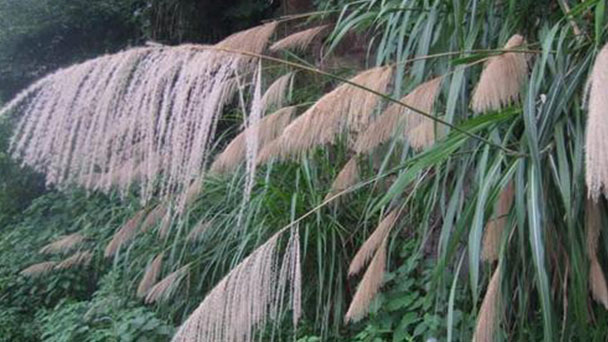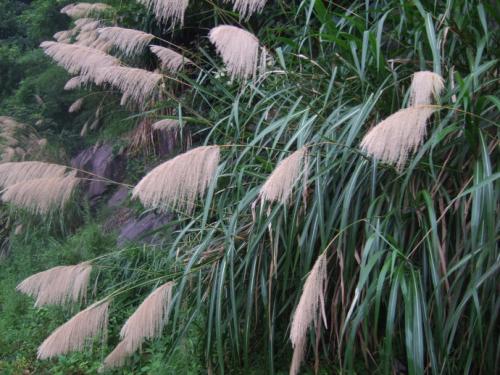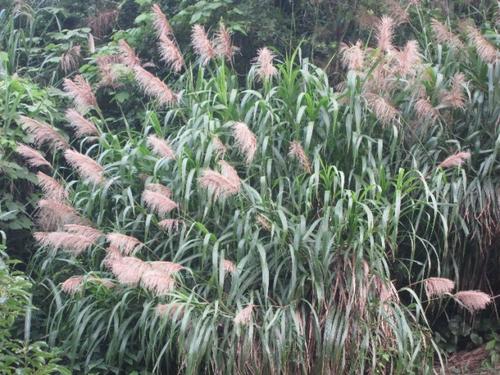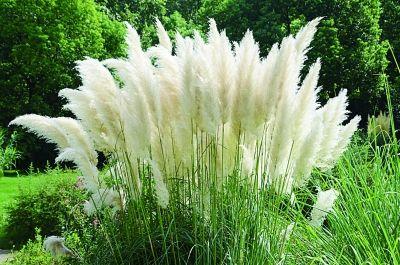Pacific Island silvergrass (Miscanthus floridulus) profile
Written by Maggie
Mar 02 2021

Pacific Island silvergrass, scientific name Miscanthus floridulus, also called Giant Eulalia Grass, Giant Chinese Silver Grass, is one of the most common wild social grasses in daily life. It thrives in groups on hillsides, near roads, streams and open land. Pacific Island silvergrass underground stems are well developed and can adapt to a variety of soils, and can grow new shoots even when the ground is cleared or burned. Pacific Island silvergrass is one of the most common wild social grasses in daily life. It grows in groups on hillsides, along roads, near streams and open land. Its underground stems are well developed and can adapt to a variety of soils. Pacific Island silvergrass is a perennial evergreen herb with white powder in the awn. The leaves are alternate, and their margins contain the siliceous material used to make glass, which can cut skin and be painful. Large panicles, 30-50 cm long, spikelets in pairs, but unequal stalk, full spikelets pale yellow at maturity.
Pacific Island silvergrass picture

Morphological characteristics of Pacific Island silvergrass
Pacific Island silvergrass is an annual herb, with well-developed rhizomes. Culms are tall like bamboo, 2-4 m tall, glabrous, with white powder under nodes, leaf sheaths glabrous, sheath nodes with hairs, longer than or slightly shorter than the upper nodes; Ligule is 1-2 mm long, apically ciliated; Leaf blade of Pacific Island silvergrass is lanceolate linear, 25-60 cm long, 1.5-3 cm wide, flattened, base tapered or rounded, apically long acuminate, midrib stout and raised, both surfaces glabrous, or pubescent above base, margin coarsely. Inflorescences of Pacific Island silvergrass are large, dense, 30 -- 50 cm long, main shaft stout, extending to more than 2/3 of inflorescence, glabrous; Branches are thin, 15-20 cm long, usually more than 10 clusters at the base of each node, with 2-3 back branchlets, pilose between axles; Racemes internodes are 3 -- 5 mm, glabrous, spikelets glabrous, apical slightly enlarged, short stipes 1 -- 1.5 mm, long striped curved outward, 2.5 -- 3 mm; Spikelets of Pacific Island silvergrass are ovate-lanceolate, 3-3.5 mm long, yellow, basal disc with filamentous pilose longer than spikelets; The first glumes are glabrous, the tip acuminate or has 2 microteeth, the lateral veins are intr agglutinated with 2 ridges, the mid veins between the ridges are not obvious, the upper part and the edge are rough; Second glume of Pacific Island silvergrass is as long as first glume, apically acuminate, with 3 veins, midrib ridged, scabrous, margin with short ciliate, first lemma oblong-lanceolate, slightly shorter than glume, apically obtuse, margin with ciliate; Second lemma is ovate-lanceolate, ca. 2.5 mm long, apically acute or 2-dentate, glabrous or lower margin with a few short cilia, awn 7-10 mm long, slightly scabrous, straight or lower slightly twisted; Lemma minute; Pacific Island silvergrass has 3 stamens, anthers 1.2-1.5 mm long, orange; Style is very short, stigma purplish black, protruding from mid spikelet on both sides.
Pacific Island silvergrass is a perennial herb with white powder in the awn. The leaves are alternate, and their margins contain the siliceous material used to make glass, which can cut skin and be painful. Pacific Island silvergrass has large panicles, 30-50 cm long, spikelets in pairs, but unequal stalks, full spikelets pale yellow at maturity.
Leaf back of Pacific Island silvergrass is green, no white powder under the leaf, leaf edge serrated easy to cut the skin.Monoecious, up to 4 m tall. The fruit is oval in shape. Inflorescence axes can be grouped into brooms. The ear can be used for flowers. The stem and leaves of Pacific Island silvergrass serve as the roof and forage grass, the new buds and tender shoots are for food, the stem has the effect of diuretic and detoxification, and the root can cure cough and urination disorders. At dusk, groups of Pacific Island Silvergrass flowers are swaying in the wind like cotton balls, forming waves of flowers. The scene is really poetic and inspiring.
Ecological Habits of Pacific Island Silvergrass
Habitat: forest, plain, hilly forest wetland, hilltop, valley edge of forest grass, hillside grass, hillside meadow, hillside edge of forest.

Pacific Island silvergrass distribution
Pacific Island silvergrass distributes in East Asia to Polynesia. In Taiwan, it is common in low elevation flat land. China Guangdong, Guangxi, Taiwan, Fujian, Hubei, Jiangxi, Hunan, Sichuan, Guizhou, Yunnan, Jiangsu, Zhejiang, Anhui, Hainan and other places; Australia has it, too. Pacific Island silvergrass distributes in Bonnesia; East Asia; South Pacific Islands; The Pacific Islands; Polynesia; Far East of Russia.
Pacific Island silvergrass main value
Pacific Island silvergrass can be used as flower material. Pacific Island silvergrass can be tied as a broom, leaf sheath and stem can be made of dawn paper, roofing.
The top of the tender heart can be edible, the whole plant can be used for animal husbandry.
Because Pacific Island silvergrass is resistant to drought, salt and heavy metals, salt resistance genes can be found from them and transferred to crops to make crops more salt tolerant.
Young leaves can be used as fodder, culms can be used as raw materials for paper making, rhizomes have diuretic effect.

Latest Updated
- Benefits of Bugleweed - 7 Science-backed Health Benefits
- Bugleweed Dangers & Side Effects - Is It Poisonous?
- How to Plant Evergreen Trees - What You Should Know
- When to Plant Evergreens - Grow Guide for Evergreen Trees
- 12 Wonderful Evergreen Shrubs for Your Garden
- 12 Popular Evergreen Plants with Pictures for Beginners
- When And How To Prune A Lilac Bush Like a Pro
- How to Grow & Care for Lilac Vine (Hardenbergia Violacea)
- Japanese Lilac Tree (Syringa Reticulata) Care & Propagation Guide
- Shumard Oak Pros and Cons - What to Know
Popular Articles
- Winter maintenance of Antirrhinum Majus
- How to Grow Terminalia Mantaly Tree
- How to Grow and Care for Crossostephium Chinense
- How to grow Antirrhinum Majus in spring
- Peristeria Elata (Dove Orchid) Profile: Info & Care Guide
- Underwatered Snake Plant (Sansevieria Trifasciata) - Signs And How To Fix
- How to Care for Brazilian Jasmine Plant (Mandevilla Sanderi)
- How to Grow & Care for Graptopetalum Purple Delight in Summer
- Rosa Chinensis (China Rose): Plant Growing & Care Tips
- How to Care for Baby Sun Rose (Aptenia Cordifolia)